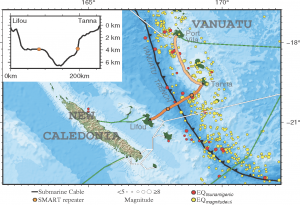UH leads game-changing earthquake, tsunami undersea early warning system
University of Hawaiʻi at MānoaResearch Professor, Ocean and Resources Engineer, School of Ocean and Earth Science and Technology
Marcie N W Grabowski, (808) 956-3151
Outreach and Educ Coord, School of Ocean and Earth Science and Technology
An effort to advance a global network of SMART seafloor cables and develop early warning systems for tsunamis and earthquakes around Vanuatu and New Caledonia is being led by the University of Hawai‘i at Mānoa. The international team received support of more than $7 million from the Gordon and Betty Moore Foundation.
“Through this project, we are developing a new ocean and Earth observing capability—sensors integrated in subsea telecommunications cables—and developing simulations and scientific protocols to provide earthquake and tsunami early warnings,” said Bruce Howe, lead investigator of the new grant and professor of Ocean and Resources Engineering in the School of Ocean and Earth Science and Technology (SOEST).
The Science Monitoring And Reliable Telecommunications (SMART) Subsea Cables initiative is gaining momentum around the world. This effort aims to integrate ocean temperature, pressure and seismic sensors into commercial submarine telecommunications systems that crisscross the ocean floor. As new systems are installed, researchers and communities hope to cost-effectively transform the current telecom network into a combined telecom and planetary-scale ocean, climate and geophysical sensor array capable of informing early warning systems.
“This brilliant project will transform the practical cables that link communications and commerce into a world-wide scientific instrument of profound importance to every person on Earth. We are delighted to help the University of Hawai‘i pioneer this game-changing effort,” said Robert Kirshner, chief program officer for Science at the Gordon and Betty Moore Foundation.
Bridging the gap
The overarching goal of the newly funded, five-year project is to help bridge the perilous gap between concept and implementation. The team aims to have sensor integration into subsea telecommunications cables become the world standard, leading to a global network for sustained ocean observation, geophysical study of earthquakes, and earthquake and tsunami warning in a world with rising sea levels.
To do this, the team will lay groundwork for the science and early warning use of undersea cables by simulations of the observing system before deployment, data analysis after deployment and sustained scientific operation.
They will apply results of the simulations to optimize the proposed Vanuatu-New Caledonia cable system and its operation. This will demonstrate the capability of the earthquake and tsunami early warning system based on the SMART sensors in one of the world’s most at-risk countries for natural disasters due to its location in the seismically active “Ring of Fire.”
A significant aspect of the project is training staff in the region to increase local expertise in related science, data management to create early warnings and predictions, and telecommunication processes. Included are workshops and courses for Vanuatu Meteorology and Geohazards Department professionals and funding for education of graduate students at the National University of Vanuatu, UH Mānoa and partner institutions—providing the science and technical foundation of a lasting observing system.
“It is critical to have a robust workforce in preparation for the new SMART cable system,” said Howe. “This will ensure operation and maintenance of the early warning systems which will help mitigate the risks of earthquake and tsunami hazards.”
Lastly, the project will support the international project office of the Joint Task Force Scientific Monitoring And Reliable Telecommunications cables, working to facilitate adoption of scientific sensors in all new subsea telecommunications cables to reach a global scale. This Joint Task Force, endorsed by the United Nations Ocean Decade for Sustainable Development, is sponsored by the International Telecommunication Union, World Meteorological Organization and UNESCO-Intergovernmental Oceanographic Commission.
Reducing risk through science, innovation, partnership
“Ideally the incorporation of SMART capability would become a routine function for the submarine cable industry,” said Howe. “Achieving this goal will generate key reductions in human and planetary risk. We hope this project is a demonstration for the global audience about how communities and science can benefit from SMART cables.”
Securing the new funding required local and international collaboration. UH Foundation facilitated working with Gordon and Betty Moore Foundation, thus bringing the project headquarters to UH Mānoa.
Project partners include: in the U. S., University of Texas – Austin, Louisiana State University, California Institute of Technology, Subsea Data Systems and Los Alamos National Laboratory; in the South Pacific University of Otago (New Zealand), French Institute for Research and Sustainable Development, National University of Vanuatu, Vanuatu Meteorological and Geohazards Department and The Pacific Community (SPC); and the International Tsunami Information Center.
About the Moore Foundation
The Gordon and Betty Moore Foundation fosters path-breaking scientific discovery, environmental conservation, patient care improvements and preservation of the special character of the Bay Area. This research is funded by the Gordon and Betty Moore Foundation through Grant GBMF10787 to the University of Hawai‘i. Visit Moore.org or follow @MooreFound for more information.
About the UH Mānoa School of Ocean and Earth Science and Technology
The School of Ocean and Earth Science and Technology at the University of Hawai‘i at Mānoa was established by the Board of Regents of the University of Hawai‘i in 1988 in recognition of the need to realign and further strengthen the excellent education and research resources available within the University. SOEST brings together four academic departments, multiple research institutes, several federal cooperative programs, and support facilities of the highest quality in the nation to meet challenges in the ocean, earth and planetary sciences and technologies.




